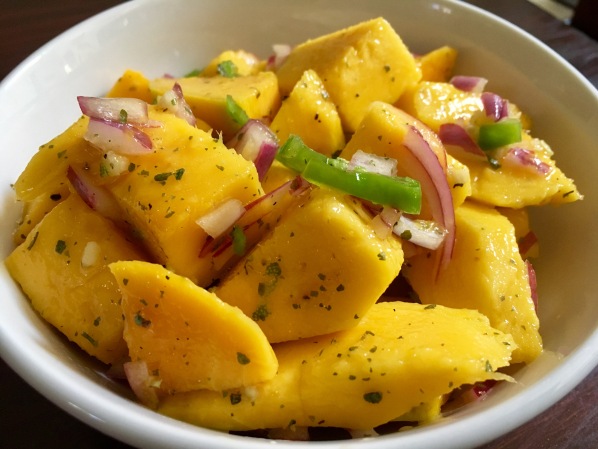Every year at the beginning of spring, we begin to see signs that mango season is approaching. A select few fruit vendors start to timidly bring out the first mangos of the season. There are mango trees to be seen all over Haiti, their branches heavy with the impending bounty of the season. By the end of April, the season has truly arrived and it will continue through June. It is a common sight to see the trucks coming from the provinces piled high with fruit as they make their way to the marketplaces. Everywhere, you will see women sitting on the side of the roads selling mangos, their baskets piled high with several varieties in different stages of ripening. To some, “a mango is a mango,” but to people of this country; this could not be further from the truth. Everyone has their personal favorite and they will argue the values, flavors, and tastes to defend their choice.
There are said to be over 100 varieties of mangos grown in Haiti. This fact even gave birth to the moniker of Haiti being known as “Mango Land”. The most sought after variety is the Francique. It is large and fleshy and well-known in the business as the best Caribbean variety. It is the King of the mangos grown in Haiti. My personal favorite is the Baptiste mango. I particularly love the Baptiste mango for its firm texture and its slightly perfumed flavor. This mango is rounder in shape and smaller than the Francique. It has an excellent ratio of flesh to seed but for me, it is the most delicious and very seldom disappoints. There are also other delicious varieties such as the Corn (elongated and slim like an ear of corn), Fil (delicious flavor but very stringy), Mme. Blanc (robust in size but bland flavor), Prune (tiny and peach colored), and Carrotte (due to the orange color akin to a carrot) to name a few.
Mangos vary in size and taste. The outward appearance can also vary from shades of green, yellow, and even ones tinged with red and purple hues. Shapes also vary from oval and slim, fat and round, small and miniature even. The flesh is also varied: some are stringy and fibrous, others luscious and smooth. Eating a mango just picked off of the tree is a childhood delight. I remember my childhood in Guyana where we sat under a friend’s mango tree and ate mangos with salt and hot pepper until our tummies ached. We still went back to repeat the process the following week!
Mangos can be used in a variety of ways. Fruit salads, juices, shakes, pies, ice cream, sorbets, and desserts are all delicious ways of using mangos. In its green form, it is made into chutneys, relishes, and pickles. High in anti-oxidants, mangos are one of nature’s perfect foods. They provide essential nutrients such as carbohydrates, sugar, dietary fibers, vitamins, minerals, iron, and calcium just to name a few.
Mango leaves are rich in Vitamin C, B & A. In folk medicine, mango leaves are used to treat diabetes when dried, boiled and crushed. They are also used to help lower blood pressure and respiratory problems by being made into a tea and drunk with honey. A soothing bath infused with mango leaves is said to aid in restlessness and allows a good night’s sleep.
Originally from Asia, the mango is definitely a part of our Caribbean culture, regardless of which Island you originate. We all love our mangos and without a doubt, the mango is really the King of the fruit! Whether the fruit was brought by the Portuguese via West Africa during the slave trade, or whether it came via our Asian ancestors on trade routes and migratory routes; we are thankful that the mango made its way to this side of the world. We all love our mangoes and without a doubt, the Mango is really the King of the fruit!
I made a delicious mango chow as we call it in the Caribbean ( ie: Guyana and Trinidad). Oddly enough, mangos are never eaten as a salad, nor are they eaten green as a pickle in Haiti. True to my Guyanese heritage, I will always like them best this way.



SPICY MANGO SALAD:
3 Francique Mangos (firm and unripened)
1/4 purple onion, sliced thin
1 scotch bonnet pepper, thinly sliced
2 cloves garlic, crushed
1 tsp salt
1 tsp honey
4 grinds of fresh black pepper
4-5 sprigs cilantro leaves, chopped fine
1/4 cup white vinegar
1 tbsp olive oil
1 lime (grate the rind and then juice the lime)
METHOD:
Peel and cube mangoes and place in a medium bowl.
In a smaller bowl, put the onions, garlic, salt, black pepper, honey, lime juice, vinegar and olive oil.
Mix together well, then add the cilantro leaves as well as the hot pepper.
Pour vinaigrette mixture over the mangoes and mix well.
Allow to marinate for about half an hour if you can manage to wait.
You can serve this as a side dish with grilled meats or you can simply eat this alone. It is so good!
Great post! Not sure if you would recall our yard in GT had 2 species my Dad planted with defined purposes – quantity and taste. The ‘Bank’ species would bare fruit most times 2lbs or more if allowed to grow, and the Juli species was all about sweetness and fragrance. I am sure Haiti has the equivalent. Ok now I have to go find me some in this barren Canadian tropical fruit landscape lol.
Hi Ainley,
Thanks for the message. I am sure that the quality was superior! In Haiti there are no Julie mangoes, but there are still many ladies there great types, each with its own special character. I hear Whole Foods sells Haitian Francique mangoes. If you have an opportunity to have any other those, try them!